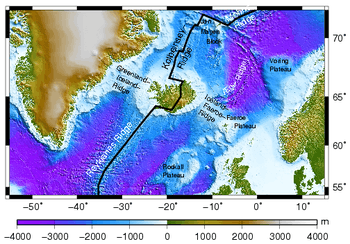Rockall Basin


The Rockall Basin (also known as the Hatton Rockall Basin) is a large (c. 800 km by 150 km) sedimentary basin that lies to the west of Ireland and the United Kingdom beneath the major deepwater area known as the Rockall Trough. It is named after Rockall, a rocky islet lying 301.4 km west of St Kilda.
Structure
The nature of the crust beneath the Rockall Trough has long been a matter of debate. Originally thought to be oceanic crust it is now generally considered to be highly stretched continental crust, although some groups of researchers continue to favour either oceanic or transitional style crust, particularly at the southern end of the basin.
The Rockall Basin forms part of a chain of highly extended Mesozoic rift basins between the Charlie-Gibb and Senja Fracture Zones, that includes; the Faeroe-Shetland Basin, the Møre Basin, and the Vøring Basin.
There are indications that the Rockall Basin developed within an earlier rift system, which is likely to be of Triassic to Middle Jurassic in age, by analogy with the nearby Slyne-Erris Basins. The age of the main rift phase in the Rockall Basin is strongly debated, with Late Jurassic, Early-, Mid- and Late Cretaceous all being suggested.
Economic geology
To date, there has been comparatively little drilling to explore for oil and gas within the Rockall Basin and only two discoveries have been made, Benbecula in the northern UK Rockall (Shell originally Enterprise Oil) and Dooish in the northern Irish Rockall (Shell originally Enterprise Energy Ireland).
The discoveries show that, at least locally, there is a working petroleum system.
Rights to exploit these resources are disputed between the UK, Ireland, Iceland and Denmark (on behalf of the Faroes). This topic is addressed in Rockall Bank dispute.
Rockall Trough
The Rockall Trough (Scottish Gaelic: Clais Sgeir Rocail) is a deep-water bathymetric feature to the northwest of Scotland and Ireland, running roughly from southwest to northeast, flanked on the north by the Rockall Plateau and to the south by the Porcupine Seabight. At the northern end, the channel is bounded by the Wyville-Thomson Ridge, named after Charles Wyville Thomson, professor of zoology at the University of Edinburgh and driving force behind the Challenger Expedition. At the southern end, the trough opens into the Porcupine abyssal plain. One of the features of the Rockall Trough is the Anton Dohrn Seamount. It lies 600 metres (2,000 ft) beneath the surface, rising 1,500 metres (4,900 ft) from the surrounding seabed.
The plateau was formed approximately 55 million years ago, a continental fragment formed between Greenland and Europe when the ancient continent of Laurasia was split apart by plate tectonics.[1] The Rockall Islet is the highest point of the plateau, rising 21 m above sealevel. It is made of a type of peralkaline granite.
The petroleum and natural gas resources in the area have been the source of political tensions between the governments of the United Kingdom, Ireland, Iceland and the Faroe Islands (a possession of Denmark).
The area supports cold water coral colonies and carbonate mound fields such as the Logachev Mounds; the trough supports a rich deep sea fish population.[2]
Features of the Rockall Plateau have been officially named after features of Middle-earth in the fiction of J. R. R. Tolkien, e.g. Eriador Seamount, Rohan Seamount, Gondor Seamount, Fangorn Bank, Edoras Bank, Lorien Knoll, Isengard Ridge.[3]
In February 2000, the RRS Discovery, a British oceanographic research vessel sailing in the Rockall Trough encountered the largest waves ever recorded by scientific instruments in the open ocean, with a SWH of 18.5 metres (61 ft) and individual waves up to 29.1 metres (95 ft).[4]
See also
References
- ↑ Igneous Rocks of the British Isles edited by D.S. Sutherland, 1982, Wiley
- ↑ WWF Brasil. "Map of Proposed MPAs". Retrieved 27 January 2008.
- ↑ General Bathymetric Chart of the Ocean Sub-Committee on Undersea Feature Names. "International Hydro-graphic Organization-Intergovernmental Oceanographic Commission General Bathymetric Chart of the Ocean (IHO-IOC GEBCO) Gazetteer of Undersea Feature Names" http://www.gebco.net/data_and_products/undersea_feature_names/
- ↑ Holliday, NP, MJ Yelland, RW Pascal, VR Swail, PK Taylor, CR Griffiths, and EC Kent (2006). Were extreme waves in the Rockall Trough the largest ever recorded? Geophysical Research Letters, Vol. 33, L05613
- R.S.Haszeldine and M.J.Russell. 1987. The Late Carboniferous northern North Atlantic Ocean: implications for hydrocarbon exploration from Britain to the Arctic. In: J.Brooks and K.W.Glennie (Eds) Petroleum Geology of North West Europe, Graham and Trotman, London, 1163–1175.
- D.Naylor, P.M.Shannon and N.Murphy. 1999. Irish Rockall Basin region – a standard structural nomenclature system. Petroleum Affairs Division, Dublin, Special Publications. 1/99.
- N.C.Morewood, G.D.Mackenzie, P.M.Shannon, B.M.O'Reilly, P.W.Readman and J.Makris. 2005. The crustal structure and regional development of the Irish Atlantic Margin. In: A.G.Dore and B.A.Vining (Eds) Petroleum Geology: North-West Europe and Global Perspectives – Proceedings of the 6th Petroleum Geology Conference, 1023–1033, Geological Society, London.
External links
Coordinates: 55°00′N 14°00′W / 55.000°N 14.000°W